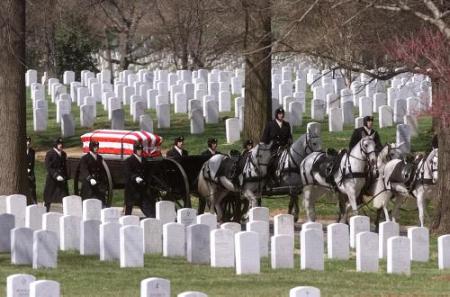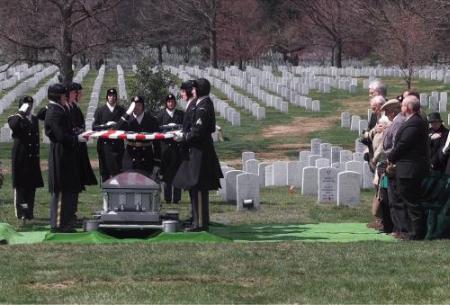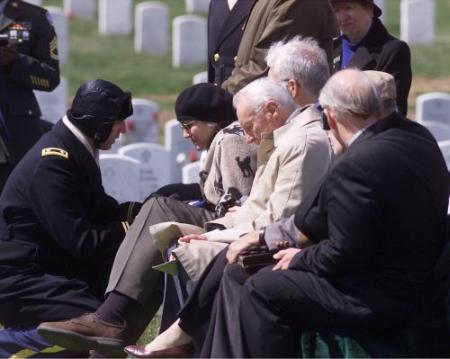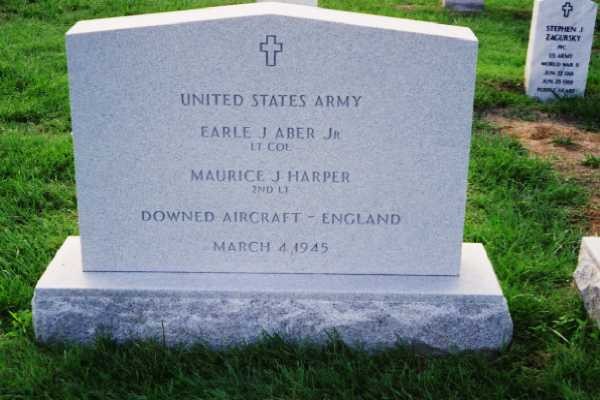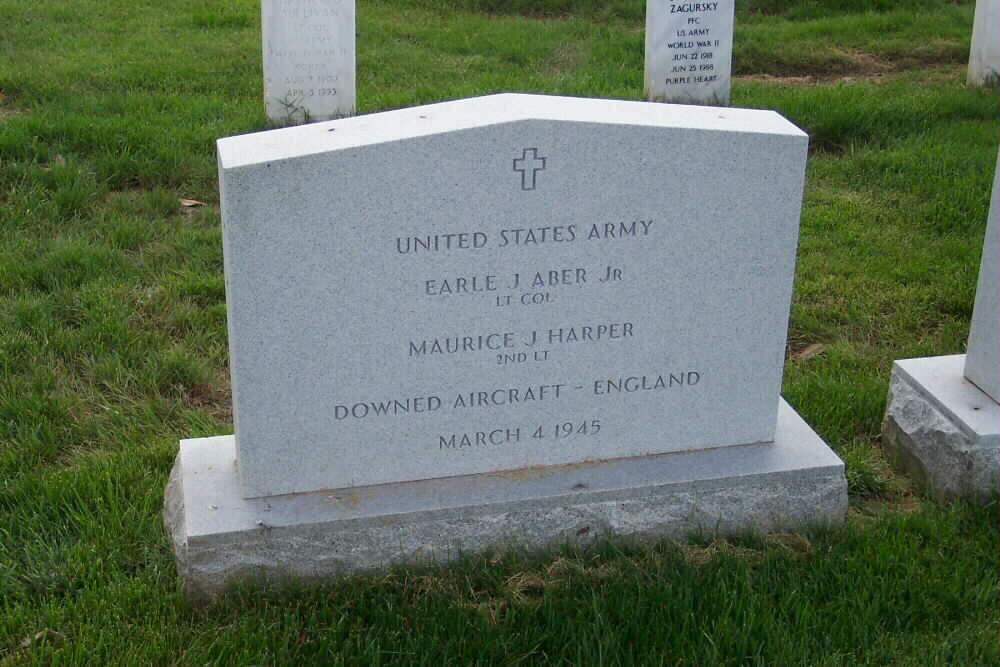From an e-mail: 14 October 2003
“Dear Arlington Cemetery:
“My sister found your web site on Lieutenant Colonel Earle Aber and Second Lieutenant Maurice Harper and their story.
“I was quite surprised that my name was not mentioned. My name is Shaun Riley and I was the qualified ocean diver who discovered the B-17 Tondalayo back in 1997. I see in your report that you mention it was found by relic hunters! Well I am not a relic hunter. I found the B-17 purely by chance and after I discovered that both pilots remained with the aircraft I made it my task to get them recovered.
“Also I read that it was found back in 1999, well this is incorrect. I found it in 1997 and have all the paper work from the British Ministery of Defence to back up my claim, basicly if I had not found the wreck in 1997 they would still be there and not laid to rest.
“I worked for the U. S. recovery team for the two weeks it took place. It started on June 9, 2000 and we finished on June 28 2000. I would be delighted to send you all the copies of my paperwork also the story from beginning to end of the recovery, which, needless to say, would be the true facts and not put together by a person or persons wishing to take the credit. Would it be at all possible for you to send me a photo of the tombstone? I would love to put it with my paperwork as I am very proud of what has been done. I also have the recovered remains of the aircraft which I am restoring for a museum display, I have also named my house after the B-17 Tondalayo.
“I hope you don`t mind my writing to you it`s just everyone seems to forget about me and the 3 years of hard work I put in to having it recovered, and credit should be given to those who actually made this piece of history happen. I look forward to hearing your reply perhaps I can help you write the full and correct story?
Yours Faithfully, Shaun Riley, England”
Two World War II airmen who died together when their plane was shot down were buried the first time 56 years and several hundred miles apart.
On Friday, newly discovered remains were buried in a single casket.
Science has made it easier to identify remains, even tiny fragments from decades-old battles. But sometimes it’s impossible to separate the remains. In such cases, the military buries them together, usually at Arlington National Cemetery.
And so, Lieutenant Colonel Earle Aber Jr. of Wisconsin and Second Lieutenant Maurice Harper of Pell City, Alabama, now share one casket and headstone.
“I like the idea,” said Harper’s sister, Mary Elizabeth Lamberth, who attended Friday’s ceremony. “They’ve been together so long, it was appropriate.”
The number of group burials has increased as the science of identification has progressed. There were nine by the Army last year, up from seven the previous year. Numbers for the other military branches were not available.
To separate remains, investigators need a fragment about the size of a quarter, said Shari Lawrence, spokeswoman for the U.S. Army Personnel Command. Smaller remains still can produce good DNA samples, but it’s impossible to separate the identities.
Aber and Harper were killed March 4, 1945, when the B-17 they were piloting was shot down off the coast of England by British gunners who mistook it for a German aircraft.
They maintained control of the plane long enough for the nine crewmen to parachute to safety, then crashed into a river estuary. Only Aber’s arm was found, identifiable by a Boy Scout ring he wore. It was buried in England in 1945.
Relic hunters discovered the plane’s wreckage in late 1999, and a team from the British Navy and the U.S. Army’s Central Identification Lab recovered it in June 2000.
Harper’s identifiable remains were returned to his family and buried last fall in Birmingham, Alabama. Aber’s identifiable remains will be laid to rest soon in England, beside his severed arm.
Major Kevin Upson of the Army’s Hawaii-based Central Identification Lab said the lab works about 265 days a year searching for the remains of missing soldiers believed killed overseas.
“You couldn’t imagine a better job in the world than when you go out and find someone and bring them back to their families,” he said.
For the Aber and Harper families, the long search has been a bonding experience.
“People talk about closure, but for us it has been an opening,” said Earle Williams, Aber’s nephew. “We’ve gotten to know lots of people who knew my uncle.”
From a News Report: 18 March 2002:
Mary Elizabeth Lamberth keeps going to funerals for her brother.
She attended one for him last fall at Forest Hill Cemetery in Birmingham. Friday she’ll attend another one, this time at Arlington National Cemetery in Washington.
In a way, he’s buried in both places.
“I will always consider Forest Hill his grave,” Lamberth said.
The fate of 2nd Lt. Maurice Harper, of Birmingham, was shrouded in mystery for more than 50 years after his death in England during World War II.
In March 1945, he was co-pilot of a four-engine B-17 bomber returning from a leaflet-drop mission over Holland. As the plane neared the English coast, it was hit by British gunners firing on a German plane in the same area.
Every crew member, except those in the cockpit, jumped to safety before the plane crashed. Harper’s remains and those of the pilot, Lt. Col. Earle Aber of Wisconsin, were entombed in the wreckage in a river estuary until being recovered in June 2000.
Army forensic scientists used DNA tests to identify some of Harper’s remains and some of Aber’s remains. However some bones could not be conclusively identified.
Harper’s identifiable remains were returned to Birmingham last October and buried in Forest Hill.
Aber’s family plans to have his identifiable remains buried in a few months at a military cemetery in England. That’s where Aber’s severed arm, identified by a Boy Scout ring he always wore, was buried after it was found at the crash site in 1945.
Officials believe the best solution for the unidentifiable bones is to put them in a single coffin. Both men’s names will go on the tombstone. Relatives of both men will attend Friday’s service.
A few personal effects, including wallets recovered in the June, 2000, excavation, have already been returned to relatives. This week in Washington both families will examine a collection of other items recovered, including coins and some keys. They can share them as they choose.
“I want the keys because they were made in Canada,” Lamberth said. Since Harper initially served with the Royal Canadian Air Force before transferring into the U.S. military, she is convinced the keys belonged to her brother.
Last October’s service in Birmingham was bittersweet for Lamberth. It was a long-overdue funeral for her brother. A few days after the funeral, she and her husband moved to Denver.
The pilot’s family have their own problems with two gravesites.
In an e-mail last week, Aber’s nephew, Earle Williams, of Boston, shared his feelings about two burial sites for his uncle.
“I would prefer that everything is in one place,” he wrote. “But, given the crazy circumstances in this case, this just cannot be.”
Williams said his uncle’s identified remains will be kept by Army officials until a service in England can be scheduled.
That will reunite his remains with the severed arm buried by itself in 1945.
Hopefully, it will help relatives solve another mystery. There are tantalizing accounts that a body maybe part of a body was recovered from the wreckage a few years after the crash. Reports say it was taken to the cemetery where his arm was buried in 1945. But cemetery records fail to record a subsequent burial.
By the 1950s, the Aber family had lost contact with Harper’s family in Birmingham. So they kept the nagging question to themselves. Williams located Harper’s sister in St. Clair County in 1999 and brought her up to date. Both families visited the recovery operation a year later in England.
WWII Airmen Buried Together
Friday, March 22, 2002
Two World War II airmen who died together when their plane was shot down were buried the first time 56 years and several hundred miles apart. On Friday, newly discovered remains were buried in a single coffin.
Science has made it easier to identify remains, even tiny fragments from decades-old battles. But sometimes it’s impossible to separate the remains. In such cases, the military buries them together, usually at Arlington National Cemetery.
And so, Lieutenant Colonel Earle J. Aber Jr. of Wisconsin and Second Lieutenant Maurice J. Harper of Pell City, Alabama, now share one casket and headstone.
“I like the idea,” said Harper’s sister, Mary Elizabeth Lamberth, who attended Friday’s ceremony. “They’ve been together so long, it was appropriate.”
The number of group burials has increased as the science of identification has progressed. There were nine by the Army last year, up from seven the previous year. Numbers for the other military branches were not available.
To separate remains, investigators need a fragment about the size of a quarter, said Shari Lawrence, spokeswoman for the U.S. Army Personnel Command. Smaller remains still can produce good DNA samples, but it’s impossible to separate the identities.
Aber and Harper were killed March 4, 1945, when the B-17 they were piloting was shot off the coast of England by British gunners who mistook it for a German aircraft.
They maintained control of the plane long enough for the nine crewmen to parachute to safety, then crashed into a river estuary. Only Aber’s arm was found, identifiable by a Boy Scout ring he wore. It was buried in England in 1945.
Relic hunters discovered the plane’s wreckage in late 1999, and a team from the British Navy and the U.S. Army’s Central Identification Lab recovered it in June 2000.
Harper’s identifiable remains were returned to his family and buried last fall in Birmingham, Alabama, Aber’s identifiable remains will be laid to rest soon in England, alongside his severed arm.
Major Kevin Upson of the Army’s Hawaii-based Central Identification Lab said the lab works about 265 days a year searching for the remains of missing soldiers believed killed overseas.
“You couldn’t imagine a better job in the world than when you go out and find someone and bring them back to their families,” he said.
For the Aber and Harper families, the long search has been a bonding experience.
“People talk about closure, but for us it has been an opening,” said Earle Williams, Aber’s nephew. “We’ve gotten to know lots of people who knew my uncle.”
Courtesy of the American Battle Monuments Commission:
Earle J. Aber, Jr.
- Lieutenant Colonel, U.S. Army Air Forces
- O-437946
- 406th Bomber Squadron, 305th Bomber Group, Heavy
- Entered the Service from: Wisconsen
- Died: March 4, 1945
- Buried at: Plot F Row 3 Grave 125
- Cambridge American Cemetery
- Cambridge, England
- Awards: Silver Star, Distinguished Flying Cross, Air Medal with 4 Oak Leaf Clusters, Purple Heart, French Croix de Guerre with Sword
Maurice J. Harper
- Second Lieutenant, U.S. Army Air Forces
- O2045063
- 406th Bomber Squadron, Heavy
- Entered the Service from: Alabama
- Died: March 4, 1945
- Missing in Action or Buried at Sea
- Tablets of the Missing at Cambridge American Cemetery
- Cambridge, England
- Awards: Silver Star, Air Medal with Oak Leaf Cluster, Purple Heart
The remains of Airman Maurice Harper and pilot Earle Aber who died together
when their B-17 bomber was shot down off the English coast 57 years ago, arrive
during funeral services at Arlington National Cemetery in Arlington, Va. Friday,
March 22, 2002. The two were buried in the same coffin. Thanks to scientific
advancements, the military is better able to identify soldiers, although sometimes
the remains are impossible to separate. In such cases, the remains often are placed
in the same casket.
Members of the Aber and Harper familes take part in funeral services for the
remains of Airman Maurice Hopper and pilot Earle Aber, who died together when
their B-17 bomber was shot down off the English coast 57 years ago, Friday, March
22, 2002, at Arlington National Cemetery in Arlington, Va. They were buried in the
same coffin. Thanks to scientific advancements, the military is better able to
identify soldiers, although sometimes the remains are impossible to separate. In
such cases, the remains often are placed in the same casket.
Members of the Aber and Harper families take part in funeral services for the
remains of 2nd Lt. Maurice J. Harper and pilot Earle Aber, who died together when
their B-17 bomber was shot down off the English coast 57 years ago, Friday, March
22,2002 at Arlington National Cemetery in Arlington, Va.. The two were buried in the same coffin.
Michael Robert Patterson was born in Arlington and is the son of a former officer of the US Army. So it was no wonder that sooner or later his interests drew him to American history and especially to American military history. Many of his articles can be found on renowned portals like the New York Times, Washingtonpost or Wikipedia.
Reviewed by: Michael Howard

